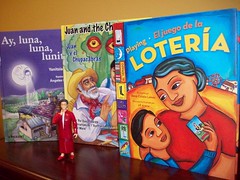The workshop is open to school district staff in the Region One area and to lurkers from outside of Region One, however, only Co-op members who complete the entire program are eligible to receive 18 hours of Continuing Professional Education (CPE) credit through Region One. Registration is a two-step process. First participants seeking CPE credit must register online for Workshop #31445 at http://www.esc1.net/staffdevelopment and the second step in the registration process occurs after you have completed the first three "Things." To receive CPE credit you must complete all 23 things by December 15, 2010. In addition, you must keep track of your progress in the "23 Things Log" form and submit the document electronically when you are finished to esc1library@gmail.com. You may download the form at http://esc1learning23things.pbwiki.com/f/23ThingsLog.doc.
Tutorial Format:
Each week begins with a brief explanation of a new web 2.0 topic, followed by Discovery Exercises. These exercises give you the background you need to understand the tools you're learning about. Don't skip them! After the Discovery Exercises, you'll find a Thing -- activity -- to complete. Then you comment or "post" to your online log (Blog) about what you learned and how the tools can be used in education. You will learn how to set up a blog soon. This is a tool to communicate your feelings, new found skills, ideas, questions, and favorite websites. A link to your blog will be posted in the "Links" area of the 23 Things home page. You'll receive feedback from me and from other participants. (Yes, giving your feedback to some of the other participants is a requirement for credit). It's your space! The links below will take you to each week's specific lesson.
The activities are organized by week to assist in pacing of the workshop. You may work ahead as long as you maintain the order of the activities. Create a separate post for each "thing" and don't forget to include the number and name of the "thing" in title of the post.
Activity for Thing #1: Read this blog and find out about the program. In your first post, write an introduction to your blog and post your reflections about what you anticipate in this workshop.
Table of Contents
Thing #1: Read this blog and find out about the program.
Thing #2: Discover a few pointers from lifelong learners and learn how to nurture your own learning process.
Week 2: BloggingThing #3. Set up your own blog , add your first post, add an avatar.
Thing #4. Register your blog and begin your 2.0 journey.
Week 3: Photos & ImagesThing #5. Explore Flickr and learn about this popular image hosting site.
Thing #6. Have some Flickr fun and discover some Flickr mashups & 3rd party sites.
Thing #7. Create a blog post about anything technology related that interests you this week.
Week 4: RSS & NewsreadersThing #8. Learn about RSS feeds and set up your own Bloglines newsreader account.
Thing #9. Locate a few useful library related blogs and/or news feeds.
Week 5: Play Week
Thing #10. Play around with with an online image generator.
Thing #11. Explore any site from the Web 2.0 awards list, play with it and write a blog post about your findings.
Thing #12. Roll your own search tool with Rollyo.
Week 6: Tagging, Folksonomies & TechnoratiThing #13. Learn about tagging and discover Del.icio.us (a social bookmarking site)
Thing #14. Explore Technorati and learn how tags work with blog posts.
Thing #15. Read a few perspectives on Web 2.0, Library 2.0 and the future of libraries and blog your thoughts.
Week 7: WikisThing #16. Learn about wikis and discover some innovative ways that libraries are using them.
Thing #17. Add an entry to the Region One Sandbox.
Week 8: Online Applications & ToolsThing #18. Take a look at some online productivity (word processing, spreadsheet) tools.
Thing #19. Take a look at LibraryThing and catalog some of your favorite books.
Week 9: Podcasts, Video & Downloadable Audio
Thing #20. Discover YouTube and a few sites that allow users to upload and share videos.
Thing #21. Podcasts (You don’t need an iPod!)
Thing #22. eBooks and Audio eBooks
Thing #23. Summarize your thoughts about this program.
Copyright, Creative Commons, and CONGRATULATIONS!












